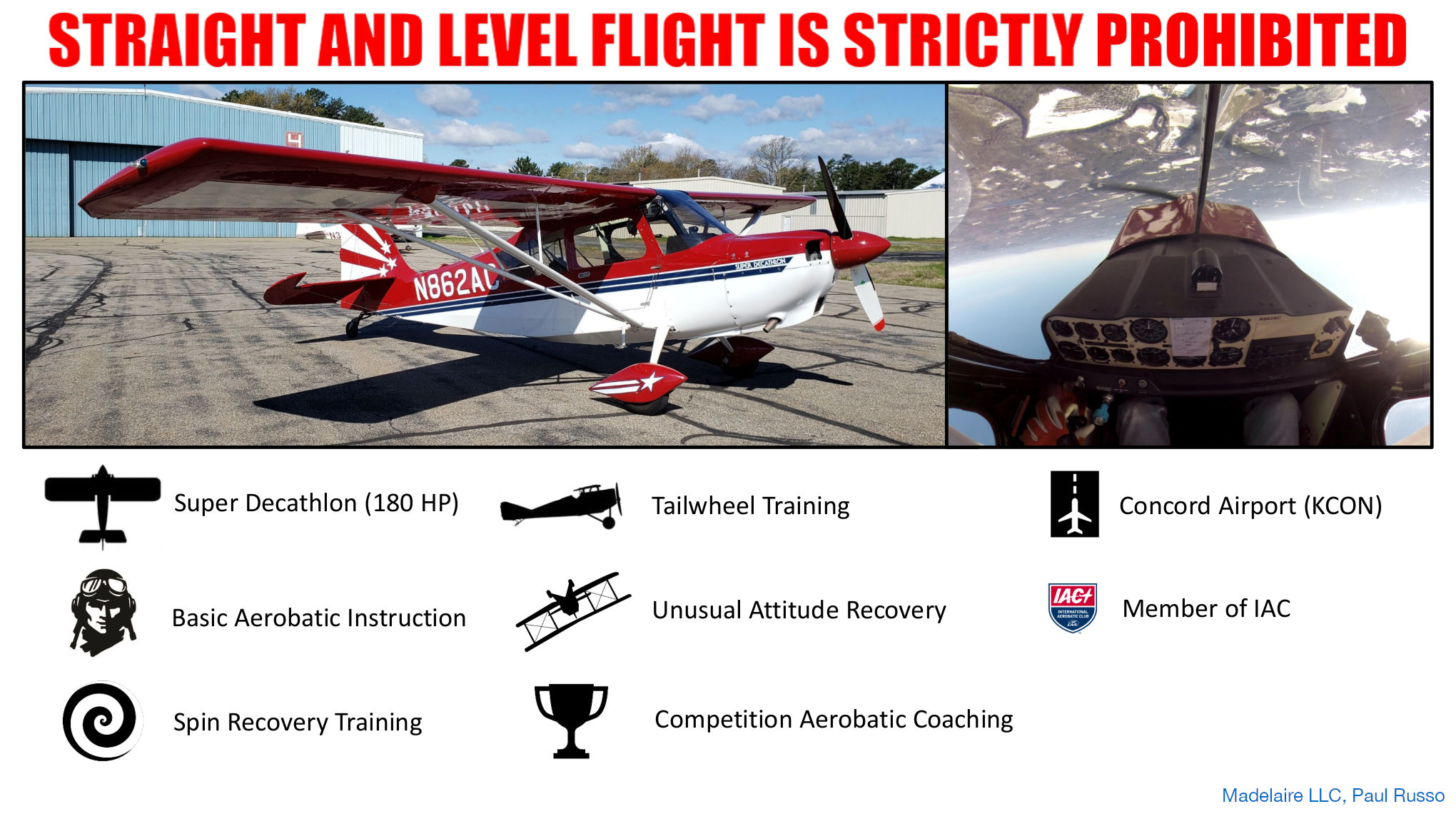Competition Aerobatics
Competition Aerobatics vs Upset Recovery Training
Competition aerobatics differs greatly from upset recovery training, even though superficially they seem to be similar. In competition aerobatics, all maneuvers are well choreographed and predictable. They are executed consistently the same, with the goal to impress the judges. The student imitates the control inputs of the instructor as closely as possible. In this fashion, one could teach an aerobatic competition spin without ever mentioning the word “stall”.
Upset recovery training is very different. Spins and other unusual attitudes are entered from a variety of situations. Dealing with out-of-control situation is an important part of the training – something you never want to be doing during a competition. Transferability to other aircraft is also required, whereas in competition aerobatics you train specifically for a make and model. For this reason, upset recovery requires a lot of theoretical education and understanding, while competition aerobatics does not. (You will still need to read and learn things on the ground, like how to read the Aresti notation, but the information is more of the sort where the nose of the aircraft is pointing and which control surface to actuate at any given time, not a deep academic discourse, just like a ski racer does not study the physics of snow in a formal mathematical fashion.)
Competition aerobatics is, however, a great extension even for pilots who primarily seek upset recovery training. It will make you much more familiar and comfortable with all-attitude flight and the corresponding physical sensations, until eventually flying inverted will feel second nature to you.
The above discussion is a simplification. As an aerobatic pilot flying solo, of course you will want to have recovery capabilities from botched maneuvers as well. But your recovery training is again specific to the aircraft make and model you fly, without general considerations, which simplifies the matter greatly. And for your first competitions, you will probably want to fly with your instructor/coach in the back seat, so unless you own your own aerobatic aircraft, flying solo has little priority.
Competition aerobatics can be highly challenging, and winning contests in the Intermediate and Advanced Category takes a lot of time and effort put into many practice sessions. However, the lower categories, Primary and Sportsman, are reasonably accessible with a small to moderate amount of practice. The key to winning an aerobatics contest is to follow the instructions of your instructor/coach as accurately as possible during practice, and then remember them for the competition. But a necessary prerequisite is that your instructor has a lot of experience: it is a nontrivial affair to be able to tell from inside the cockpit, whether your figures are nice and symmetrical. While at higher levels you may use ground observers, initially you will probably rely exclusively on the feedback from your aerobatics instructor/coach in the back seat.

Competition Aerobatics Course
Academic Flight LLC is more oriented towards upset recovery training than competition aerobatics. In order for you to have a higher quality training experience in competition aerobatics, we collaborate with Madelaire LLC’s founder Paul Russo in New Hampshire and promote his aerobatics course here. Paul is an experienced aerobatic competitor, winning regularly in the Advanced Category. We are very impressed not only with his flying skills, but also with his teaching style and the resulting performance outcome. He swiftly led us to a first contest win at the Keene Fall Classic in the Primary Category, despite our lack of prior competition experience. If you are a somewhat experienced pilot who is serious about competition aerobatics, or eager to learn, Academic Flight LLC will provide you with maneuver notes which arose from our training with Paul and will put you in touch with him and his company. His dual training aircraft, an American Champion 8KCAB Super Decathlon, is featured in the poster above. A video made by one of his students can be seen here. Please contact us.
“The benefit of improved airmanship through learning and flying aerobatics cannot be emphasized enough, from my perspective. To really know how to respond to any upset condition, aerobatics will teach you what control inputs are required to move the nose of the aircraft in the direction you want it to go, irrespective of your speed and attitude. This is my mantra and what I tell prospective pilots.”
Paul Russo
Maneuvers
The aerobatics maneuvers you will learn for the Primary and Sportsman Categories include (not all maneuvers listed below are competition maneuvers, but are useful to round off your training):
- Loop
- Aileron Roll (not a competition maneuver)
- Slow Roll
- Barrel Roll (not a competition maneuver)
- Immelmann
- Split-S
- Cuban Eight
- Hammerhead
- Competition Spins (with a vertical downline during recovery)
- Aerobatic Turns
- Inverted Flight (including inverted turns)
Tailwheel Endorsement
If you do not already have a tailwheel endorsement, you can obtain one either with us or with Madelaire LLC, before commencing your competition aerobatics training. During the tailwheel training, you will learn 3-point and wheel landings, crosswind landings, soft-field landings on a grass runway, short-field landings, power-off wheel landings on a designated mark, a practical introduction to the simulated engine failure after takeoff turnaround maneuver, and more. Much of the practice is conducted on a long runway for efficient learning of wheel landings. For the tailwheel endorsement, typically 5-6 hours are required for a pilot with normal capability (but a few more may be needed depending on your ability). The tailwheel endorsement can be completed on one weekend if you are willing to fly 3 times a day and are capable. However, we recommend you split it into two weekends, with a break In between, so the impressions settle in more – if you learn something over a brief period of time, you will also forget it more quickly.

